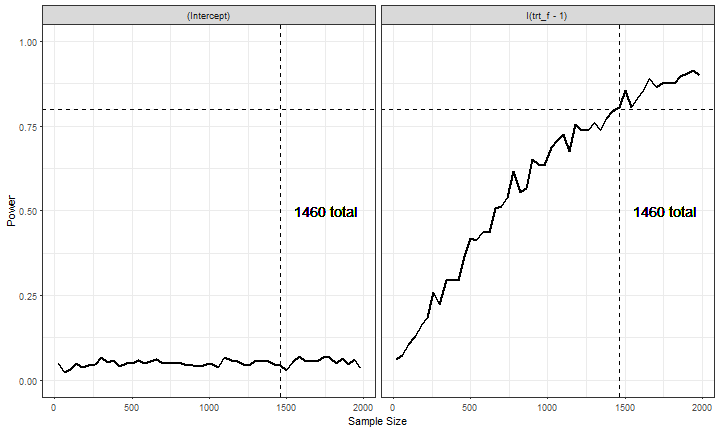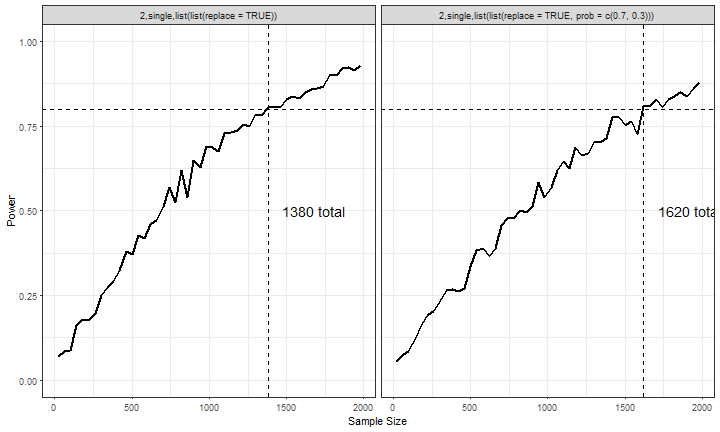Simulation and Power Analysis of Generalized Linear Mixed Models
Brandon LeBeau
University of Iowa
Overview
- Power
simglmpackage- Shiny Demo
Power
- Power is the ability to statistically detect a true effect (i.e. non-zero population effect).
- For simple models (e.g. t-tests, regression) there are closed form equations for generating power.
- R has routines for these:
power.t.test, power.anova.test - Gpower3
- R has routines for these:
Power Example
n <- seq(20, 1000, 5)
power <- sapply(seq_along(n), function(i)
power.t.test(n = n[i], delta = .15, sd = 1, type = 'two.sample')$power)

Power for (G)LMM
- Power for more complex models is not as straightforward;
- particularly with messy real world data.
- There is software for GLMM models to generate power
- Optimal Design: http://hlmsoft.net/od/
- MLPowSim: http://www.bristol.ac.uk/cmm/software/mlpowsim/
- Snijders, Power and Sample Size in Multilevel Linear Models.
- Moerbeek & Teerenstra, Power Analysis of Trials with Multilevel Data.
Power is hard
- In practice, power is hard.
- Need to make many assumptions on data that has not been collected.
- Therefore, data assumptions made for power computations will likely differ from collected sample.
- A power analysis needs to be flexible, exploratory, and well thought out.
Why do power?
- Three common reasons to do power analysis:
- Power evidence for grant/planning
- Post Hoc to explore insignificant results
- Monte Carlo studies
simglm Features
- Longitudinal data simulation
- Three levels of nesting
- Specification of distribution of random components (random effects and random error)
- Specification of serial correlation
- Specification of the number of variables
- Ability to add time-varying covariates
- Specify the mean and variance of fixed covariate variables
- Factor variable simulation
- Ordinal variable simulation
simglm Features Continued
- Power by simulation
- Vary parameters for a factorial simulation design.
- Can vary model fitted to the data to misspecify directly.
- Simulation of missing data
- Include other distributions for covariate simulation.
- Continuous, Logistic (dichotomous), and Poisson (count) outcome variables.
Replicate with simglm
- Note this code uses the development version on GitHub
library(simglm)
fixed <- ~ 1 + trt_f
fixed_param <- c(0, 0.15)
fact_vars <- list(numlevels = 2, var_type = 'single',
opts = list(list(replace = TRUE)))
n <- NULL
error_var <- 1
with_err_gen <- 'rnorm'
pow_param <- c('(Intercept)', 'I(trt_f - 1)')
alpha <- .05
pow_dist <- "t"
pow_tail <- 2
replicates <- 500
terms_vary <- list(n = seq(20, 2000, 40))
power_out <- sim_pow(fixed = fixed, fixed_param = fixed_param, cov_param = NULL,
n = n, error_var = error_var, with_err_gen = with_err_gen,
fact_vars = fact_vars,
data_str = "single", pow_param = pow_param, alpha = alpha,
pow_dist = pow_dist, pow_tail = pow_tail,
replicates = replicates, terms_vary = terms_vary,
raw_power = FALSE, lm_fit_mod = sim_data ~ I(trt_f - 1))
Plot Results

More Realistic?
terms_vary <- list(n = seq(20, 2000, 40),
fact_vars = list(list(numlevels = 2, var_type = 'single',
opts = list(list(replace = TRUE))),
list(numlevels = 2, var_type = 'single',
opts = list(list(replace = TRUE,
prob = c(.7, .3))))))
pow_param <- c('I(trt_f - 1)')
power_out <- sim_pow(fixed = fixed, fixed_param = fixed_param, cov_param = NULL,
n = n, error_var = error_var, with_err_gen = with_err_gen,
fact_vars = fact_vars,
data_str = "single", pow_param = pow_param, alpha = alpha,
pow_dist = pow_dist, pow_tail = pow_tail,
replicates = replicates, terms_vary = terms_vary,
raw_power = FALSE, lm_fit_mod = sim_data ~ I(trt_f - 1))
Results

Shiny Demo
- Once the package is installed, can run the Shiny app locally.
run_shiny()
Connect
- Twitter: @blebeau11
- Website: https://brandonlebeau.org
- Slides: https://brandonlebeau.org/slides/jsm2017.html
- GitHub: http://github.com/lebebr01/simglm
Simulation and Power Analysis of Generalized Linear Mixed Models
Brandon LeBeau
University of Iowa